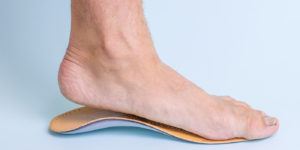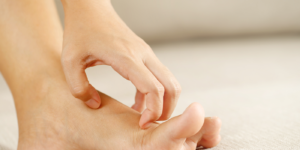Many people experience pain from flat feet, commonly known as fallen arches. When the foot arches collapse, the entire sole touches the ground, causing this common symptom. There are ways to reduce flat foot pain and improve function. This page covers flat foot causes, symptoms, and treatments.
Understanding Flat Feet
Flat feet can be broadly categorized into two types:
1. Flexible Flat Feet
In cases of flexible flat feet, the arches are only flat when weight is placed on the feet. When the person is not bearing weight, the arches may appear normal. This type is typically hereditary and often does not cause discomfort.
2. Rigid Flat Feet
The arches of rigid flat feet are flattened regardless of standing. This condition usually has a structural cause and causes pain.

Common Causes of Flat Feet
Causes of flat feet include:
Heredity: Flat feet are largely genetic. If your parents or grandparents have flat feet, you may too.
Aging: Flat feet may result from weakening foot arches and tendons with age.
Pregnancy: A woman’s feet can change during pregnancy. Increased weight and hormonal changes can lead to flat feet during pregnancy.
Injury: Trauma or injury to the feet can cause damage to the tendons or bones, potentially resulting in flat feet.
Obesity: Excess body weight can put a strain on the feet and lead to the development of flat arches.
Symptoms of Flat Feet
Flat feet can manifest in various ways, and the severity of symptoms can vary. Common symptoms include:
- Pain in the arches, heels, or ankles
- Foot fatigue or aching after standing or walking
- Reduced flexibility in the foot
- Difficulty finding comfortable shoes that provide adequate support
- Overpronation, which is when the foot rolls too far inward while walking
- Corns and calluses due to uneven pressure on the feet

Managing and Improving Flat Feet
There are various successful flat foot management and improvement methods. Here are some steps:
1. Supportive Footwear
Invest in supportive shoes with good arch support. Look for footwear designed specifically for individuals with flat feet or those that can accommodate custom orthotics.
2. Custom Orthotics
Custom-made orthotic insoles can provide extra arch support and help distribute weight more evenly across the foot. A podiatrist can create these inserts tailored to your unique foot shape and needs.
3. Stretching and Strengthening Exercises
Foot muscles and tendons can be strengthened and flexed with certain workouts. A physical therapist or podiatrist can customize an exercise regimen.
4. Weight Management
Maintaining a healthy weight can prevent foot strain and flat foot pain.
5. Footwear Modifications
In some cases, simple modifications to your shoes can make a significant difference. This may include adding arch support or using shoe inserts.
6. Rest and Ice
Resting and icing your feet can relieve discomfort and inflammation.
7. Medication
Over-the-counter painkillers like ibuprofen can reduce flat foot discomfort and irritation. Before using any drug, visit a doctor.
8. Orthotic Devices
Orthotic devices, such as braces or splints, can provide additional support for the feet and reduce discomfort, particularly during activities.
9. Physical Therapy
A physical therapist can help you establish a treatment plan that includes foot muscle strengthening and flexible exercises.
10. Surgery (in severe cases)
In severe cases of flat feet, surgery may be considered. Surgical options include tendon repair, realignment of bones, or joint fusion.
Preventing Future Issues
Preventing the development or worsening of flat feet is essential. To maintain healthy feet, consider the following:
- Wear supportive, well-fitting shoes that provide arch support.
- Avoid high heels or shoes with inadequate support for prolonged periods.
- Stay active and maintain a healthy weight to reduce stress on the feet.
- Pay attention to any discomfort or pain and seek medical advice promptly.
Conclusion
Many of the symptoms of flat feet can be relieved with proper treatment. You may improve your flat feet and live pain-free by wearing the right shoes, using orthotic inserts, and exercising properly. Consult a doctor or podiatrist for specialized advice and treatment for severe or persistent discomfort.


